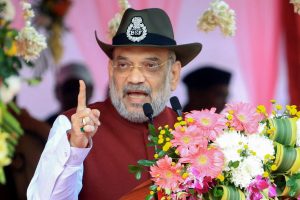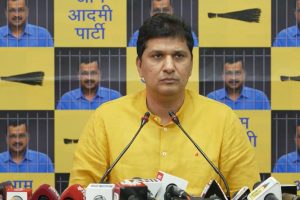This year’s Nobel Prize to David Card for his experimental work with Alan Krueger ~ on empirical findings disapproving the common perception that raising minimum wages will cost jobs ~ is a clarion call for developing economies such as India to urgently review their minimum wages system.
“Everyone knew” raising minimum wages would result in no money being left with employers to meet increasing costs with adverse impacts on employment generation. But the study that brought the Nobel Prize found no evidence that raising the minimum wage costs jobs. According to the International Labour Organisation (ILO), “minimum wages are the minimum amount of remuneration that an employer is required to pay wage earners for the work performed during a given period, which cannot be reduced by collective agreement or an individual contract.
The purpose of minimum wages is to protect workers against unduly low pay”. India is known as being one of the first developing countries to pioneer regulations related to minimum wages and payment of wages even before its independence. India’s minimum wages system got strengthened with the introduction of the Minimum Wages Act, 1948 that served the country from 1948 till the recent introduction of the Code on Wages, 2019.
In a judgment, the Hon’ble Supreme Court (1992 AIR 504) held that employers have no right to be in business if they are not capable of paying the minimum wage. The minimum wage is both the entry and exit level wage for unduly low paid workers of all age groups and it is the only means of survival for them and their families. An appropriate setting up of minimum wages by policymakers and their enforcement can bring a significant change in the lives of numerous wage earners in India.
There are a total of 50 crore workers in India, of whom 90 per cent are categorized as unorganized and around 10 per cent as organised. This shows the potential of using minimum wage as a policy tool to revive the consumption-led economy to boost aggregate demand. In India, the Minimum Wages Act 1948 made minimum wages applicable for “scheduled employments”. This means employment specified in the schedule or any process or branch of work forming part of such employment. The fixation of minimum wage and its applicability to schedule of employment falls within the jurisdiction of both State Governments/UTs and the Central Government.
That has amounted to as many as 429 scheduled employments (45 in the Central sphere) and 1,915 scheduled job categories for unskilled workers (GOI, 2018). Therefore, the enforcement of so many categories of minimum wages became quite difficult and to some extent impossible. The revision of minimum wages, especially in States and Union Territories, has not been seen as a periodical affair; rather the issue has been left unattended for quite some time.
The minimum wages are also not correlated with the cost-of-living index from time to time by many States/UTs. That has resulted in (as per the Economic Survey, 2018-19) major variations in the number of scheduled employments, for example three in Mizoram and 102 in Assam. Similarly, Nagaland has the lowest minimum wage of Rs 115/day which goes up to Rs 538/day in Delhi. And the highest minimum wage is seen at Rs 135/day in Nagaland against Rs 1192/day in Kerala.
There are two concepts relating to minimum wage that exist in India, i.e. the minimum wage, and the national floor-level minimum wage. The national floor-level minimum wage is a concept mooted in 1992 by the Central Government to reduce the disparities in minimum wages among States and Union Territories. However, it was indicative in nature and not binding on states. Since June 2017, the national floor-level minimum wage has not been updated with the cost of living and has been left untouched at Rs 176/day.
Interestingly, these numbers relating to minimum wages of States and the national floor-level minimum wage (NFLMW) lack a proper scientific methodology for fixation at the base level. It has been observed that the present minimum wages fall short of an adequate value for taking care of the needs of workers and their families even in scheduled employment. Employment such as domestic work which is not even covered under the Minimum Wages Act, 1948 have less than the prevailing minimum wages of scheduled employment.
Therefore, the Code on Wages, 2019 made the provisions of the applicability of minimum wages universal; however, there is an absence of an appropriate scientific methodology which considers both the domestic and international scenarios as well as covers the guidelines referred to by ILO. The guidelines of the ILO especially “the Minimum Wage Fixing Convention, 1971 (No. 131)” are quite clear and helpful in setting the minimum wage at a reasonable level. The convention has provided a minimum wage level that takes into account the needs of workers and their families as well as economic factors, and the role of collective bargaining.
An expert committee for determining the methodology for fixing the national minimum wage was set up by the Ministry of Labour and Employment. It suggested a scientific methodology based on balanced diet approach to calculate minimum wages in India with a nationally representative food basket for all regions. It suggested a national minimum wage of Rs 375/day at July 2018 prices (Rs. 9750/month) irrespective of sectors, skills, occupations and rural-urban location.
The estimation was based on the consumption expenditure survey 2011-12 while minimum wages at regional levels were also estimated with the same basket considering regional prices. The basket considered a 2400 kcal diet, with 50-gram proteins, 30-gram fats as well as nonfood items, both essential and others. This included 3.6 consumption units considering the average household size of India. An average additional city compensatory allowance of Rs 55 per day for urban workers over and above the national minimum wage was also recommended. But the recommendations have not been accepted yet.
It has been further highlighted (Satpathy and Malick, 2020) that the common criticism of minimum wage setting and its adjustments interfering with market forces in wage setting and raising labour costs, resulting in layoffs of workers, is not true. This seems to be an invalid consideration when minimum wages were set and adjusted reasonably with the appropriate methodology. However, fears that minimum wages per se led to employment losses appear to lack empirical verification.
Instead, a growing number of studies nationally and internationally including an ILO publication of 2008 indicate that the relationship between the minimum wage and employment is not necessarily negative. And if minimum wage is set at a reasonable level, it can increase the number of workers with access to decent wages and reduce the gender pay gap with little or no adverse impact on employment. Further, there is no evidence found on any potential displacing employment effect of minimum wages in the case of India (Belser and Rani, 2011).
The research supports the assumption that minimum wages redistribute incomes without hurting employment. It has also been highlighted that standard neo-classical economics has overly emphasized the adverse effects of minimum wages on employment. They also state that based on an assessment of recent academic literature more than 650 economists and five Noble prize winners and six past presidents of the American Economic Association issued a statement that higher minimum wages can significantly improve the lives of unduly low paid workers and their families.
A recent brief of ILO (Sharma and Estupinan, 2021) on “Impact of minimum wages on wages and employment in selected Indian states” revealed that more than 50 per cent proportion of workers in states such as Chhattisgarh (73.19), Madhya Pradesh (69.81) and Uttar Pradesh (59.05) are not receiving minimum wages. States such as Delhi (49.88) and Odisha (48.79) are close to that mark. States such as Rajasthan and Himachal Pradesh show 13.61 and 15.80 state-wise proportion of workers not receiving the minimum wages as per the PLFS Survey 2017-18 and 2018-19.
The sectors where nearly half the workers do not receive minimum wages are food product and beverages, construction, wholesale and retail trade, and repair and maintenance of motor vehicles. The findings on the impact of minimum wages show that minimum wages in most Indian states are low enough to catalyze positive impacts on employment if raised. It further shows that a one per cent increase in minimum wages increases employment by 0.623 per cent and 0.582 per cent (accounting for both district and state fixed effects).
The result also provides evidence that minimum wages impact positively both wages and employment in industrial groups such as the manufacture of food products and beverage; textile and apparel; water supply; sewage; waste management; construction; wholesale and retail trade, and repair of motor vehicles. The Swedish academy’s Nobel Prize for experiments and findings against the idea that imposing or increasing the minimum wage would cost jobs is another testimony to urgently emphasise on fixation, adjustment and enforcement of minimum wages in India by making the Code on Wages, 2019 effective.
This is also the right time to raise minimum wages appropriately and adequately in all occupations in all states and adjust it with the cost of living from time to time. The Central Government may also urgently update the present NFLMW and may further recommend a national minimum wage with its newly set up committee for handholding of the states with respect to fixing and determining a robust scientific methodology for this purpose. Awareness among large numbers of illiterate and low-paid unorganized workers can also be emphasised adequately for a visible working of the minimum wages system in the country.
(The writer is an Indian Economic Service Officer and works as Deputy Director in the Ministry of Finance. The views expressed are personal)











